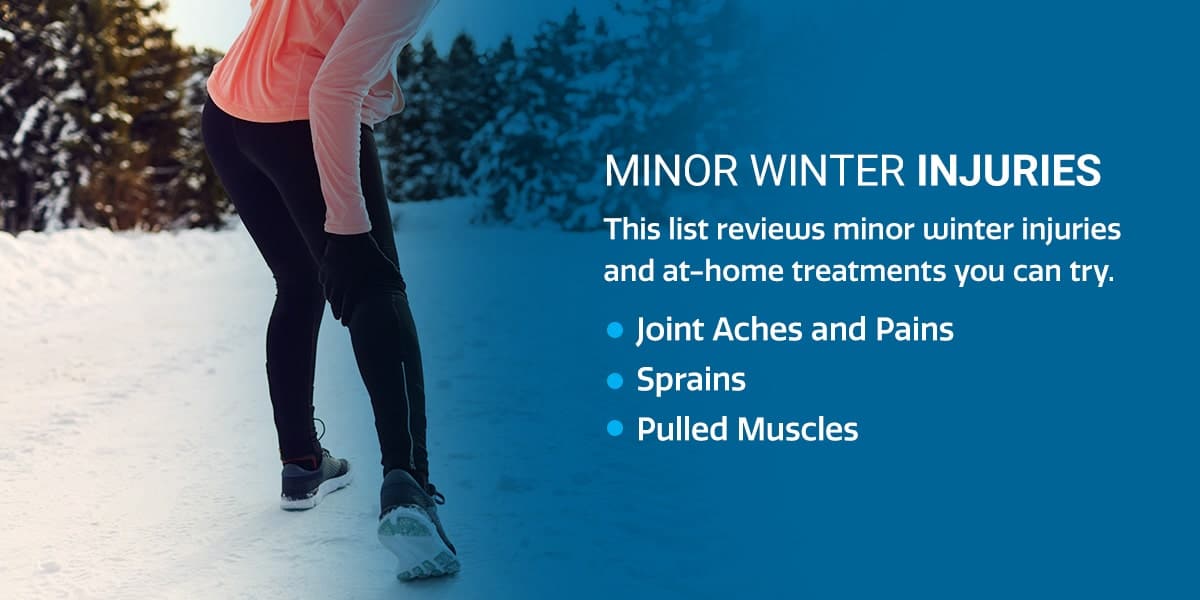The colder winter temperatures usher in ice and snow. These slippery conditions can increase your chance of injury, and cold temperatures can cause aches and pains in your joints. Many of these conditions are not severe, meaning you can safely treat them at home.
This guide will review common winter injuries and at-home treatments you can try and tell you when a doctor’s opinion might become necessary.

Minor Winter Injuries
This list reviews minor winter injuries and at-home treatments you can try.
Joint Aches and Pains
The pain from inflammatory conditions such as arthritis, tendonitis and bursitis can worsen during winter. People with past injuries, such as sprains, breaks, joint replacements, fusions, screws or plates, may also notice pain during the colder months. This is because the colder temperatures can make it difficult for blood to circulate to the extremities.
Some things you can do to reduce your joint pain include:
- Dressing warmly
- Exercising
- Maintaining a healthy weight
- Avoiding unnecessary strain on your joints during daily activities
- Using heating pads on painful areas
- Stretching before going outside
- Getting plenty of rest
Exercises you can do in the winter to fix aches from cold weather include:
- Stationary cycling: Cycling strengthens the muscles that support your knees without putting stress on them or your hips.
- Yoga: This exercise improves your flexibility, mobility and range of motion. It can improve balance and coordination and strengthen the muscles around your joints. Yoga also relieves stress and tension.
- Strengthening exercises: Strengthening your muscles causes less strain on your joints, which reduces inflammation, stiffness and pain. A strong body and core improve your balance and coordination and makes it easier to do everyday tasks.
These exercises can help lessen joint pain, but if you notice any of the following symptoms, you should consult a doctor:
- Persistent swelling
- Redness
- Difficulty using or putting pressure on the joint
Sprains
Ankle sprains are the most common type of sprains during winter. They often occur when you slip on an icy surface, causing the foot to twist inward and stretch or tear the ligament. There are three levels of sprains:
- Mild: When the ligament stretches, but the joints are functional, it is a mild sprain. Moving the joint is painful, and swelling may last up to 24 hours. These sprains take about one to two weeks to heal.
- Moderate: The ligament stretches and partial tears with a moderate sprain. Moving the joint is painful and difficult. It often swells a few hours after the injury, and a bruise might form. It will take about four to six weeks to heal.
- Severe: With a severe sprain, the ligament has ruptured. You might have felt the ligament tear when the injury occurred. This sprain is extremely painful, and you cannot move the joint. Swelling occurs in a few minutes, and a bruise will appear. It takes eight to twelve weeks to heal.
You can treat most sprains at home with:
- RICE: Rest, ice, compression, elevation. Rest and stay off your injury for two to three days. Apply ice to the ankle several times daily to reduce pain and swelling, and use a compression bandage. Keep your ankle elevated above your heart to reduce the flow of blood to the injury.
- Pain medication: Take over-the-counter pain medication to reduce pain and swelling.
- Soak: After a few days, soak your ankle in warm water with Epsom salt. Epsom salt may help soothe sore muscles and connective tissues and help with joint stiffness.
- Natural remedies: Garlic, onion, turmeric, castor oil and olive oil help reduce swelling. Gently heat any of these ingredients, apply them to your ankle and wrap it with a bandage for several hours.
If your sprain is severe or you think it could be a fracture, you should see a doctor. A severe sprain can require surgery or physical therapy to heal.
Pulled Muscles
When shoveling snow, you can pull muscles in your back or neck. To prevent this, you can push the snow away and keep a slight bend in your knees. If you experience back pain after shoveling snow, you can:
- Rest for the first few hours and avoid unnecessary or sudden movements.
- Take over-the-counter pain medication, such as ibuprofen.
- Use lidocaine or other topical creams.
- Use heating or cooling pads for 48 hours.
- Keep your lower back in an inclined position.
- Gently stretch your back.
You should see a doctor if you experience any:
- Numbness in the genital or groin areas accompanied by bladder or bowel control loss.
- Weakness in the foot or the inability to lift it.
- Severe back pain with or without leg pain.
Serious Winter Injuries
More severe winter injuries can occur from falls. Over 800,000 people are hospitalized each year due to a fall injury. Slipping on ice is the equivalent of being knocked off your feet and slammed into the ground. Parking lots, stairs, sidewalks and steps are common places where winter-related slip-and-fall accidents happen.
To prevent falls, you should wear proper footwear, walk slowly, keep your stride short and sprinkle de-icer or sand on the slippery areas around your home. If you slip and start to fall, you can tuck and protect your head, turn your body to lessen the impact and keep your muscles loose.
Serious injuries resulting from slips and falls include:
- Head or brain injuries
- Broken bones
- Back injuries
- Spinal cord injuries
After a fall, you should:
- Breathe easy and evaluate your injuries: Don’t try to get up immediately after a fall. Instead, breathe deeply and focus on assessing your pain and injuries.
- Stay put or slowly rise: Try to wiggle or gently touch your body parts. If you hurt your leg after falling on the ice, try to stretch it out. If you feel any intense pain, stay put and call for help. As long as the pain isn’t extreme, you can slowly get up. When you cannot get up but are in a dangerous place, gently scoot or roll to a safer place.
- Keep warm: If you are immobilized, keep warm by moving your arms and legs in wide arcs until help can arrive.
- Seek medical attention: Seek medical attention after a fall to rule out serious injuries, even if you feel okay. However, medical attention may not be necessary if you can get up and move around.

Schedule an Appointment With FASA Family Wellness
After a fall or winter injury, it can be hard to determine the extent of it. Sometimes, an injury feels mild, only to become moderate or severe the next day. Our physical therapists at our Tumwater and Lacey offices of FASA Family Wellness want to help you get back to what you enjoy doing.
Call us at 360-754-3338 to schedule an appointment today. We offer same-day or next-day appointments.




